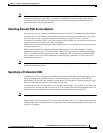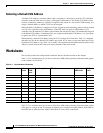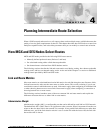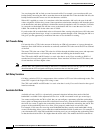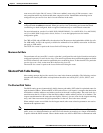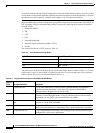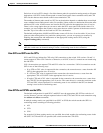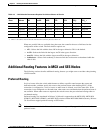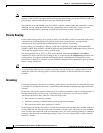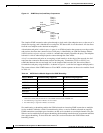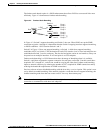
4-5
Cisco PNNI Network Planning Guide for MGX and SES Products, Release 5
Part Number OL-3847-01 Rev. D0, April, 2004
Chapter 4 Planning Intermediate Route Selection
How MGX and SES Nodes Select Routes
Each class of service SPT is simply a list of the shortest paths for a particular routing metric to all known
destinations. AW SPTs list the shortest paths or routes based on the lowest cumulative AW, and CTD
SPTs list the shortest routes based on the lowest cumulative CTD.
The number of shortest paths stored in a SPT for any destination depends on whether there are multiple
routes with the lowest routing metric value. For example, if three routes to a destination all have the same
minimum CDV value, all three routes are listed in the CDV table for the appropriate class of service.
There is also a range option that you can use to make the SPTs store routes with similar values. For
example, you can configure the switch to store routes that are within 5 percent of the shortest route in
the table. Up to five routes can be listed in a SPT for a destination.
The default configuration of MGX and SES nodes creates all 10 class of service tables. If you do not
plan to use the routing tables for a particular routing metric, you can save processor resources by
disabling the construction and maintenance of the appropriate routing metric SPTs (using the
cnfpnni-routing-policy command).
Note If you disable the creation of one or more groups of SPTs and a connection attempts to use a missing
table, the switch uses on-demand routing to locate a conforming route for the connection.
How SVCs and SVPs use the SPTs
SVCs and SVPs are initiated by CPE using UNI connections to the switch. UNI versions 3.0 and 3.1
cannot request a CTD or CDV value for a connection, so all UNI 3.0 and 3.1 connections are routed using
the AW SPTs.
UNI 4.0 connections can request CTD and CDV values for a connection. UNI 4.0 connections use the
SPTs in one of the following ways:
• If no CTD or CDV value is requested for the connection, the connection uses a route from the AW
SPT for the appropriate class of service.
• If a CTD or CDV value is requested for the connection, the connection uses a route from the
appropriate CTD or CDV SPT for the appropriate class of service.
• If both a CTD and a CDV value is requested for the connection, the connection uses a route from
the CTD SPT for the appropriate class of service. The route chosen is a route that conforms to the
CTD and CDV values requested. If a conforming route is not available in the SPT, on demand
routing is used to find a conforming route.
How SPVCs and SPVPs use the SPTs
The default configuration for each SPVC and SPVP uses the appropriate AW SPT for each class of
service. However, you can configure requested values for AW, CTD, and CDV for each connection using
the addcon and cnfcon commands.
If multiple routing metrics are specified for an SPVC or SPVP, the switch searches the SPTs for
conforming routes according to following priorities:
1. AW
2. CTD
3. CDV
For example if all three routing metrics are specified, the switch searches for conforming routes in the
AW SPTs. If CTD and CDV are specified, the switch searches the CTD SPTs.



